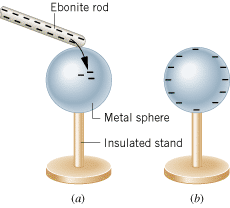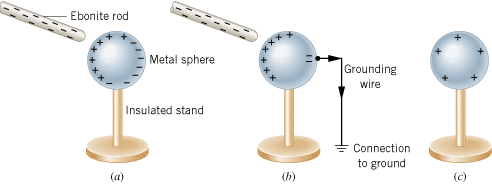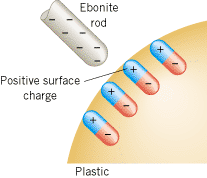18.4.
Charging by Contact and by Induction
When a negatively charged ebonite rod is rubbed on a metal object, such as the sphere in Figure 18.7a, some of the excess electrons from the rod are transferred to the object. Once the electrons are on the metal sphere, where they can move readily, they repel one another and spread out over the sphere’s surface. The insulated stand prevents them from flowing to the earth, where they could spread out even more. When the rod is removed, as in part b of the picture, the sphere is left with a negative charge distributed over its surface. In a similar manner, the sphere would be left with a positive charge after being rubbed with a positively charged rod. In this case, electrons from the sphere would be transferred to the rod. The process of giving one object a net electric charge by placing it in contact with another object that is already charged is known as charging by contact.
 | | Figure 18.7
(a) Electrons are transferred by rubbing the negatively charged rod on the metal sphere. (b) When the rod is removed, the electrons distribute themselves over the surface of the sphere. |
|
It is also possible to charge a conductor in a way that does not involve contact. In Figure 18.8, a negatively charged rod is brought close to, but does not touch, a metal sphere. In the sphere, the free electrons closest to the rod move to the other side, as part a of the drawing indicates. As a result, the part of the sphere nearest the rod becomes positively charged and the part farthest away becomes negatively charged. These positively and negatively charged regions have been “induced” or “persuaded” to form because of the repulsive force between the negative rod and the free electrons in the sphere. If the rod were removed, the free electrons would return to their original places, and the charged regions would disappear.
 | | Figure 18.8
(a) When a charged rod is brought near the metal sphere without touching it, some of the positive and negative charges in the sphere are separated. (b) Some of the electrons leave the sphere through the grounding wire, with the result (c) that the sphere acquires a positive net charge. |
|
Under most conditions the earth is a good electrical conductor. So when a metal wire is attached between the sphere and the ground, as in Figure 18.8b, some of the free electrons leave the sphere and distribute themselves over the much larger earth. If the grounding wire is then removed, followed by the ebonite rod, the sphere is left with a positive net charge, as part c of the picture shows. The process of giving one object a net electric charge without touching the object to a second charged object is called charging by induction. The process could also be used to give the sphere a negative net charge, if a positively charged rod were used. Then, electrons would be drawn up from the ground through the grounding wire and onto the sphere.
If the sphere in Figure 18.8 were made from an insulating material like plastic, instead of metal, the method of producing a net charge by induction would not work, because very little charge would flow through the insulating material and down the grounding wire. However, the electric force of the charged rod would have some effect, as Figure 18.9 illustrates. The electric force would cause the positive and negative charges in the molecules of the insulating material to separate slightly, with the negative charges being “pushed” away from the negative rod. Although no net charge is created, the surface of the plastic does acquire a slight induced positive charge and is attracted to the negative rod. For a similar reason, one piece of cloth can stick to another in the phenomenon known as “static cling,” which occurs when an article of clothing has acquired an electric charge while being tumbled about in a clothes dryer.
 | | Figure 18.9
The negatively charged rod induces a slight positive surface charge on the plastic. |
|
| Check Your Understanding 1 |
 |
|
Two metal spheres are identical. They are electrically neutral and are touching. An electrically charged ebonite rod is then brought near the spheres without touching them, as the drawing shows. After a while, with the rod held in place, the spheres are separated, and the rod is then removed. The following statements refer to the masses mA and mB of the spheres after they are separated and the rod is removed. Which one or more of the statements is true? (a) mA = = mB, (b) mA> mB if the rod is positive, (c) mA < mB if the rod is positive, (d) mA > mB if the rod is negative, (e) mA < mB if the rod is negative. mB, (b) mA> mB if the rod is positive, (c) mA < mB if the rod is positive, (d) mA > mB if the rod is negative, (e) mA < mB if the rod is negative.
Background:
Mass and electric charge are both properties of electrons and protons. In a metal, which move, electrons or protons? An object can be given an electric charge by contact with another charged object or by induction.
For similar questions (including calculational counterparts), consult Self-Assessment Test 18.1, which is described at the end of Section 18.5.
|
|
 |
 |
| Copyright © 2000-2003 by John Wiley & Sons, Inc. or related companies. All rights reserved. |



